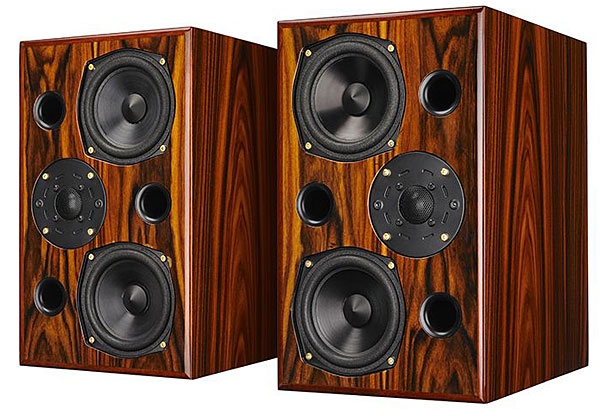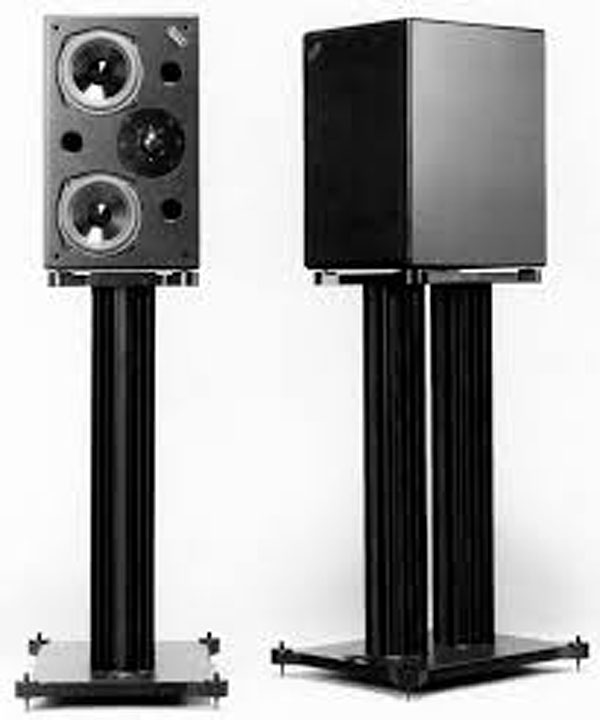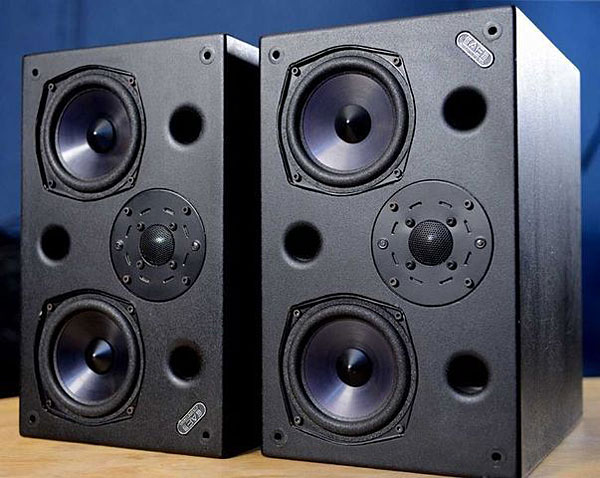| Columns Retired Columns & Blogs |
Acoustic Energy AE2 loudspeaker

This review was originally published in February 1990. It was one of the magazine's first reviews to feature measured performance taken with DRA Labs' MLSSA system.
Footnote 1: To judge by the details of the casting, the top plate for this stand also serves as the bottom plate for a similar stand intended for use with the AE1. This uses just one finned, lead-filled pillar.
In the September 1988 issue of Stereophile, I wrote a rave review about the first speaker, the AE1, from what was to me a totally unknown English company, Acoustic Energy. Though tiny, and possessing an intrinsically limited low-frequency response, the $1500/pair AE1 was one of the most musical loudspeakers I have ever used, throwing a deep, beautifully defined soundstage, and possessed of a clean treble and a sweet, if rather forward-balanced, midband. It was also technically unusual in that it featured a metal-cone woofer (though the deep anodizing used as a surface treatment meant that it should rather be regarded as a ceramic-metal-ceramic–sandwich cone). It has been a puzzle to me that no other US magazine has picked up on the AE1: get with it, you guys; even at its four-digit price, the AE1 is a musical bargain.
Which brings me to the AE2. Considerably more expensive at $2500/pair, the '2 features the same metal-dome tweeter as the AE1, sourced from the British ELAC company, but marries it to two of the diminutive metal-coned woofers. Three narrow, slightly flared ports on the front baffle, 1" in diameter and 5.5" deep, reflex-load these woofers, and a steep-slope, 24dB/octave crossover divides the audio band at 3kHz. The cabinet, finished on all surfaces with a "nubbly" black paint, is constructed from 25mm MDF, with the sidewalls loaded with plaster. It felt decidedly nonresonant! The speakers are supplied as a mirror-imaged pair. They can also be used on their sides, with the tweeter at the top. I didn't try this, however.
The big surprise for me with the AE2 was its recommended stand. At $1280/pair, costing as much as several Class C speakers in Stereophile's "Recommended Components" listing, these 25"-high stands must be the most expensive in the world!

They are also probably the most sturdy. Each has two vertical pillars comprised of a finned aluminum extrusion some 4" in diameter, inside of which is a polyethylene bag filled with lead shot. These pillars are bolted to cast-aluminum top and bottom plates; the top plate has four small cones at the corners to make contact with the speaker (footnote 1); the bottom plate is fitted with four carpet-piercing spikes, these adjustable from above with an Allen wrench. (At the front of the baseplate is a small bubble-level.)
The sound
Setting the speakers up for the optimum sound proved problematic in that it was all too easy to get a midrange-forward balance with rather a shouty low treble. I tried facing the speakers straight ahead, both with the tweeters on their inside edges and on the outside edges; I also tried the speakers toed-in to the listening seat with the tweeters on either edge. The low treble was slightly better balanced with the mids when the speakers were listened to slightly off-axis on the woofer side. (Off-axis on the tweeter side, the sound was rather too bright.) I ended up, therefore, with the speakers toed-in with the tweeters on the outside edges.
The sound was still a little shut-in in the top two octaves. Changing to the Wadia 2000 processor was a disaster, the sound becoming considerably more shut-in. I therefore replaced the Kinergetics CD player with the Proceed, which has a little more subjective HF energy. This gave a more successful treble balance; I carried out all my serious auditioning with this combination. As the AE2 seems very sensitive to such small changes, however, I recommend that you take the advice of your Acoustic Energy dealer about what components will enable it to give of its best.
Once I was satisfied that I had the speakers set up optimally, I sat down to some serious listening. That the AE2 has some tonal character was apparent. But before I discuss it, let me just tell you that this speaker was in some ways the best I have ever auditioned. Forget its physical size—its sound was BIG, with more "jump factor" than any other domestic model I have used. Whether it was on rock—the bottom-falling-out-of-your-Universe bass guitar at the start of Thomas Dolby's "Pulp Culture" from Aliens Ate My Buick (EMI-Manhattan CDP-7-48075-2)—or classical—the brass-motifs-over-rustling-strings suspense at the start of the Intermezzo of Sibelius's Karelia Suite (London 414 534-2)—the AE2s demonstrated an uncanny ability to make the hairs on the back of my neck stand on end.

Recorded drums never sounded anything but impactful, making my reference Celestion SL700s, which are tonally more neutral, sound rather wimpy by comparison. And at high levels, loud, climactic sounds didn't obscure the smaller details of the sound, something that is almost ubiquitous with smaller loudspeakers, in my experience.
The soundstage produced by the AE2s was also big, with an astonishing sense of "air" and space. A much-played album these days in the Atkinson household is a sampler (footnote 2) from the French Astrée label: track 4 is a virtuosic solo from gamba player Jordi Savall; at one point he bangs the strings of his instrument, illuminating what the AE2s revealed to be a vast space around the instrument.
The soundstage was also well-defined, with instrumental and vocal images possessing a considerable degree of palpability. About the only anomaly regarding the AE2s' ability to throw a wide, deep, well-defined soundstage was in the mid-treble, where there was a degree of "splash" to the sides. A dual-mono pink-noise signal revealed the narrow central image to be appreciably wider in the presence region (the frequency band where the speaker's woofer crosses over to the tweeter).
Again and again, however, my listening notes mentioned the feeling of "space" created by these Acoustic Energy speakers. Every time I turned the system on, this aspect thrilled me.
Which is why I was disappointed by the speaker's relative lack of neutrality in the midrange. Violins and violas acquired an "eee" character, which in itself was relatively benign, the listener becoming accustomed to it. But this was accompanied by a rather "hooty" quality, particularly noticeable on recorded piano at reasonably high replay levels, and on trumpet at lower levels. In particular, with the London Sibelius recording mentioned above, the trumpet took on a "bark" in its middle register that made me want to turn the volume down. (This was particularly ironic in view of the fact that the excellent dynamics and lack of congestion in the treble and lower-midrange and bass of these speakers in general made me want to turn the volume up.)
Higher and lower in frequency, the AE2 seemed remarkably uncolored. Apart from a slight accentuation of the flute's breath-noise "chiff," Stereophile's Poem LP (STPH001-1) reproduced as well as I have ever heard it in the treble, the instruments being set well back in the hall acoustic (though the depthwise separation between flute and piano was not as great as it should have been). And the piano's lefthand registers literally "purred." In fact, listening with the lights off to natural organ recordings, such as the Michel Chapuis track on the Astrée sampler, the subjective bass extension seemed so good that when I turned the lights on, it came as a rude shock to be reminded how small the speakers really are. That this subjective low-frequency extension is due to a considerable extent to the stand was confirmed by replacing them with 24" wooden stands from Chicago Speaker Stands. Though the basic tonal character of the AE2 remained, much of its spatial magic and bass authority had gone.
Conclusion
I found the AE2 to be very fussy both when it came to finding the optimum placement in the room and in choosing source components that enabled it to sing. Although it is relatively expensive even without stands, the dedicated stands are also essential, in my opinion, to getting the most from the AE2. This, of course, puts the system price almost up to $3800, where even small faults become of paramount importance. Its small but noticeable midrange-coloration level might then be thought by some to be a major failing. But if you are more concerned about superb presentation of detail and dynamic impact, coupled with a smooth, uncolored treble, particularly if your tastes run more to rock music, then the AE2 must be considered as one of the finest speakers in this price class.
Recommended conditionally, therefore, but if Acoustic Energy can rid the AE2 of that vestigial midrange coloration, they have a speaker to rival the Wilson WATT in pushing the state of minimonitor sound to new heights of musical satisfaction.
Footnote 1: To judge by the details of the casting, the top plate for this stand also serves as the bottom plate for a similar stand intended for use with the AE1. This uses just one finned, lead-filled pillar.
Footnote 2: My thanks to Guy Lemcoe for bringing this excellent- and natural-sounding collection to my attention.
- Log in or register to post comments




































